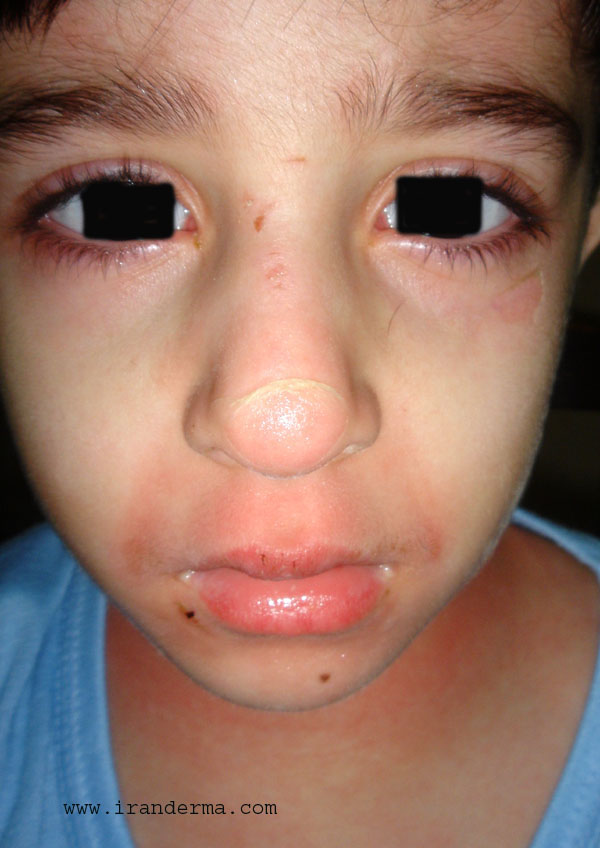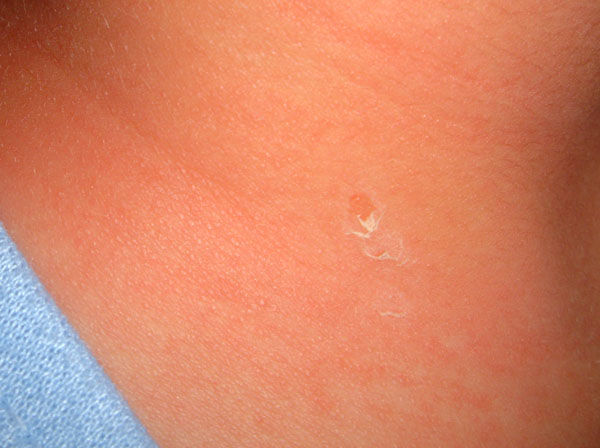IRANDERMA |
|
Quiz: February 2006 |
A 3 and half-year-old boy presented with sudden onset of painful erythematous skin eruptions. The rash was more prominent around the neck, axillae and periorificial regions. There was no mucosal lesions. Nikolski's sign was positive. The patient had mild fever, but otherwise was in good health. He was on no medications and had not any other significant medical problem.
What is your diagnosis?


Diagnosis: Staphylococcal Scalded Skin Syndrome (SSSS)
Comment by; M. Mehravaran, MD, Dermatologist/ Szeged, Hungary:
SSSS
is a generalized confluent, superficially exfoliative disease occurring
most commonly in neonates and young children. It was known in the
past as Ritter’s disease or dermatitis exfoliativa
neonatorum. It has been reported to occur rarely in adults
patients such as immunocompromised one.
Infection
or mucous membrane colonization with toxin-producing S.aureus may
cause skin cleavage at the granular cell layer. Most patients are
children less than 5 years old (as in Quiz case). Fever and
irritability precede a generalized macular eruption, which
progresses to diffuse erythema. Vesicles and bullae develop,
followed by skin seperation.
Clinically
the earliest signs is young children are fever and irritability.
A generalized eruption, initially faintly macular, appears and
progress to diffuse erythema, often with skin tenderness. Superficial
vesicles and bullae then form, and 24 to 48 hours later the
skin over the face, neck, axillae, and groin wrinkles. The
vesicular fluid is usually sterile. Nikolsky’s sign is
present. Crusting around the facial orifices may develop,
mucous membrane erosions do not occur (majority of above
mentioned clinical change are matched with Quiz case).
Pathogenesis:
Certain strains of S.aureus, usually bacteriophage group II, produce an exfoliative toxin, which causes the epidermal cleavage. In young children the S.producing the toxin usually colonize mucous membranes such as the oropharynx or vagina, which typically appear normal and from which the toxin is readily absorbed.
Differential
Diagnosis:
- Toxic Epidermal Necrolysis (TEN) is a bullous drug eruption which have severe prognosis that is has the appearance of a widespread scalding burn. TEN also know as Lyell syndrome. In TEN the level of the split is below the epidermis, at the dermo-epidermal junction. The SSSS which have far better prognosis and skin split is at the level of granular layer and not induced by drugs or medicament (as in Quiz case).
Treatment:
In general prognosis is good. Antibiotics of choice is a penicillinase-resistant penicillin such as cloxacillin or dicloxacillin and first-generation cephalosporin, eradicate the toxin-prodcing organisms from the mucosal surfaces. In severe cases drainage of abscesses also required, and fluid loss management is severe scalded patients.
ايران درما |